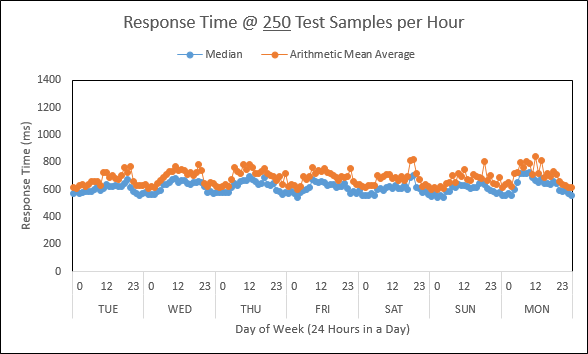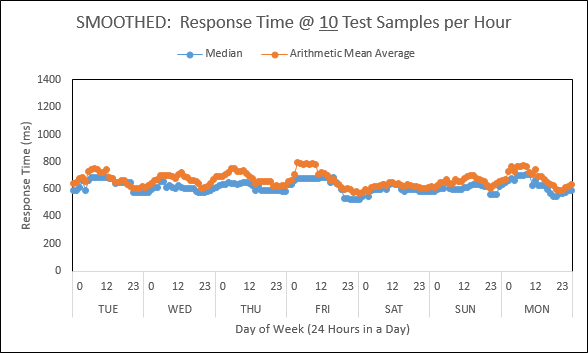Response:
Hello! This #WebTortoise post was written 2013-JUL-31 at 06:44 PM ET (about #WebTortoise).
Main Points
#- Big Data doesn’t have to be the biggest; it has to be just Big Enough.
#- Sampling versus not sampling can affect your information both negatively or positively. For example, on one end of the spectrum, not sampling at all has effect of missing transient blips or subtle pattern changes. Where, on the other end, sampling at an extremely low rate has effect of being noisy, choppy or volatile.
#- Always remember Performance versus Availability. For example, the rate for your passive Performance data may be different than the rate for your active Synthetic data.
#- Nothing is perfect. Therefore, everything is imperfect.
Story
In this Webtortoise story, going to look at the impact of sampling as it pertains to web performance measurements. Started with a week’s worth of data (no particular reason for a week’s worth; just have settled on that as a default time period), totaling @ 42K test samples (@ 250 per hour).
In this below chart 1, we’re looking at both a Median and Arithmetic Mean Average Performance chart calculated using all of the 250 Synthetic Test Samples per hour. Nice and smooth… Can see some fluctuation during peak vs non-peak… Arithmetic Mean versus Median is not too large of a delta… All in all, not a bad looking chart.
Now compare with this below chart 2 except are randomly selecting from the same data set to plot based on 50 test samples per hour.
Now compare with this below chart 3 except are randomly selecting from the same data set to plot based on 10 test samples per hour.
Last, now compare with this below chart 4 except we’ve applied a basic data smoother to the “10 samples per hour” chart.
Then put chart 1 and chart 4 side-by-side! If the chart titles were removed, would you be able to pick the one at 250 test samples per hour versus at 10 test samples per hour?
Document Complete / OnLoad:
_The following is optional reading material._
LinkedIn: http://www.linkedin.com/in/leovasiliou
Twitter: @LvasiLiou
Download the Excel document here https://docs.google.com/file/d/0B9n5Sarv4oonTl81cF9XQzZhaUE/edit?usp=sharing
#CatchpointUser #ChartsAndDimensions #KeynoteUser #Performance #SiteSpeed #WebPerformance #Webtortoise #WebPerf #WPO
#Sampling #DataSmoothing #Statistics




